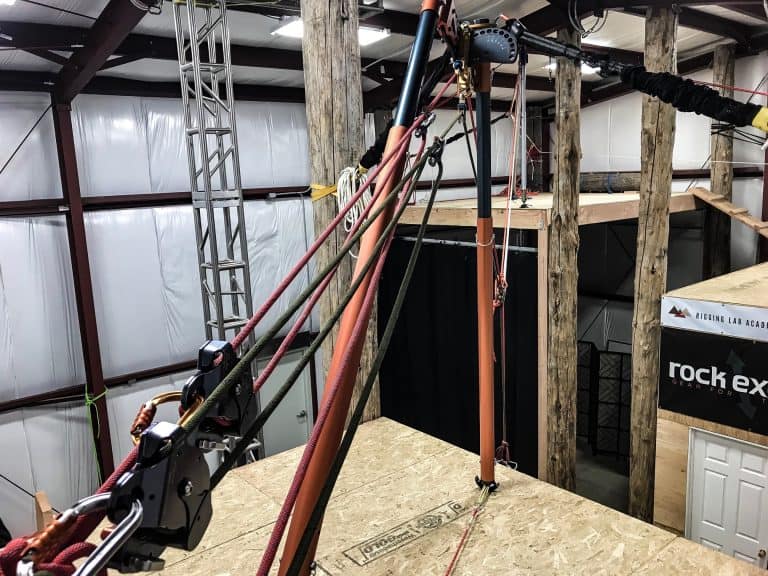Artificial High Directionals (AHDs) have become a cornerstone in technical rope rescue, providing innovative solutions to some of the most challenging scenarios. From reducing edge friction to improving load control, AHDs are essential tools for modern rescue teams. But what makes them so effective, and how can they be utilized to their fullest potential? Let’s explore the buzz surrounding AHDs and dive into their applications, benefits, and best practices.
What Are Artificial High Directionals (AHDs)?
An Artificial High Directional is a rigging structure designed to elevate rope systems. Unlike natural high points such as trees or rock outcrops, AHDs are engineered to be portable, adaptable, and easy to deploy. They come in various configurations—monopods, bipods, and tripods—each serving specific operational needs.
Key Benefits of AHDs
- Edge Transition Efficiency:
AHDs reduce rope drag and friction, making transitions smoother and safer. - Load Clearance:
By elevating rope systems, AHDs keep loads clear of obstacles, ensuring better control and reducing wear on equipment. - Adaptability:
Portable and modular designs allow AHDs to be used in diverse environments, from industrial settings to wilderness rescues.
Learn more about AHD configurations in Planning Your Artificial High Directional.
Applications of Artificial High Directionals
1. Confined Space Rescue
In confined spaces, such as silos or shafts, AHDs provide a stable and elevated anchor point for hoisting or lowering loads. Their compact design ensures efficient use of limited space.
2. Edge Transitions in High-Angle Rescues
When transitioning over sharp edges, AHDs act as a high directional to protect ropes and maintain load stability. They are particularly valuable in scenarios where natural high points are absent.
3. Industrial Maintenance and Access
AHDs are frequently used in industrial environments to create temporary high points for rigging systems, enabling workers to access elevated structures safely.
For additional insights, check out
artificial high directionals, high directional rigging, monopods, bipods, tripods, edge transitions, confined space rescue
Popular Types of AHDs
- Monopods
- Compact and ideal for confined spaces.
- Lightweight and quick to set up.
- Example Use: Narrow shaft entries where space is limited.
- Bipods
- Provide increased stability for mid-range loads.
- Commonly used in scenarios requiring moderate elevation.
- Example Use: Supporting edge transitions in high-angle rescues.
- Tripods
- The most stable AHD configuration.
- Designed for heavy loads and multi-directional rigging systems.
- Example Use: Industrial rescues involving large or complex loads.
Explore specific setups in The Gin Pole and Monopod Are Here to Stay.
Best Practices for Using AHDs
- Stabilize the System: Always use guy lines or anchor points to prevent tipping or movement.
- Inspect Components: Check for wear or damage before and after each use.
- Match the Configuration to the Task: Select the appropriate AHD type (monopod, bipod, tripod) based on the load and environment.
- Train Regularly: Ensure all team members are familiar with setup and operation procedures.
Discover more safety tips in 5 Things to Remember About Gin Poles.
Conclusion
Artificial High Directionals are indispensable tools for rescue professionals and rigging experts. Their versatility, portability, and ability to tackle complex scenarios make them a must-have for any team. Whether you’re navigating confined spaces, managing edge transitions, or working in industrial environments, AHDs provide the innovation and reliability you need to succeed.
For more on mastering AHDs and related rigging systems, explore the wealth of resources at Rigging Lab Academy.
Peace on your Days
Lance











11 thoughts on “Artificial High Directionals”
There is one environment that AHD’s are not suitable, underground/caves. Transport of any such device is incredibly difficult in most caves due to the nature of narrow passages. Often the pipes won’t even go around a corner. The weight can be very tiring to carry around over difficult terrain. Lastly there is usually many pitches so the need for many AHD’s would be needed. This further exaggerates the before mentioned problems.
773890 1970I like this site really much so significantly wonderful info. 621970
592779 430123This is often a great weblog, could you be interested in working on an interview about just how you developed it? If so e-mail myself! 745439
245525 502575As soon as I detected this internet internet site I went on reddit to share some of the really like with them. 325351
680217 754225Hello! I just wish to give a huge thumbs up for the great information youve gotten right here on this post. I will likely be coming back to your weblog for much more soon. 883188
443804 623693I adore foregathering helpful info, this post has got me even a lot more info! . 728262
Kada naudinga atlikti pastato sandarumo testą?
Statant pastatą, siekiant užkirsti kelią galimiems sandarumo defektams; Renovuojant pastatą nustatomos pastato nesandarumo vietos; Sertifikuojant naują, A, A+, A++ energinio efektyvumo pastatą, privaloma patikrinti
jo sandarumą; Įsigyjant naujos ar senos statybos būstą.
O Jones, Richard B. 20% Chance of Rain introduction to exotic option pricing Peter Buchen.
Good day! I simply would like to give a huge thumbs up for the nice info you could have right here on this post. I might be coming back to your blog for more soon.
Hello there, I discovered your website by way of Google while searching for a similar subject, your website came up, it appears to be like great. I’ve bookmarked it in my google bookmarks.
Dede torun siki XXX Videos Porn Movies BANGBROS Katia Loves Spring Break 2017 with Shag Bus
(bb15961) 12:00. 66% Pornet Xxxxbf Bbw Com.
Stepmom homosexual girl with 2 y. 3:56. 98% Aeroplane Porn Ornhub Com سکس زیبا.
Smalltits dutch adolescent jizz 10:10. 66%.
Comments are closed.